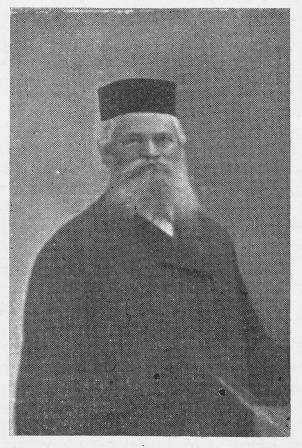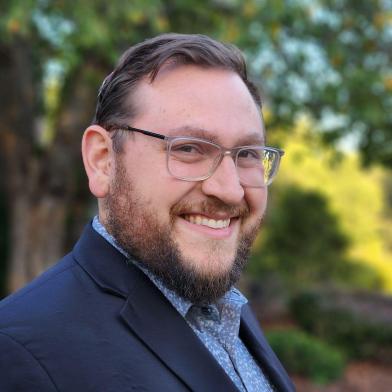Mordekhai (Mordecai; Mordkhe) Hershman was born in 1888 in Chernigov (Polish: Chernikhov) in the Chernigov Governorate of the Russian Empire, today Chernihiv in Ukraine and died in New York City on January 30, 1941. Several sources have misprinted the name of his town of birth, e.g. Chernibovo (supposedly in the Volyn Governorate; no town of that name was identified there) in Zaludkowski (1930: 274); Cherinov in Smith’s notes reproduced by Rabbi Geoffrey Shisler (see Sources below). Hershman maintained an allegiance to his place of birth many years later as shown in a note in the Forverts (Forward) of July 20, 1922 (p. 2) about his appearance (for free) on behalf of the 'Chernikhover Relief Fund'.
From an early age Hershman was a child singer in several synagogue choirs accompanying distinguished cantors. According to Zaludkowski (who probably received information directly from Hershman), Hershman sang as meshorer with Zeidel Rovner in Berdychiv (Yiddish: Barditshev) and when his voice changed from alto to tenor he joined the choir of Nissi Belzer (Nissan Spivak). After Belzer's death in 1906 he sang with cantor Meir Pisak of Berdychiv. He managed to dodge military conscription thanks to his voice, singing at this time with cantor Shlomo Ravitz.
His first post as a hazzan was in in the Chor-Shul of Zhitomir in 1913. However, he stayed there only a few months before he was offered the important position as hazzan of the Great Synagogue of Vilnus (Lithuania) at the young age of 25. During World War I, Hershman was drafted into the Russian Army, but it is said that his officer was so impressed by his tenor voice that he released him from duty so that he could return to his community in Vilnus (for an alternative version of these events, see below). After the war, Hershman toured Russia and Europe, performing at synagogues and as a soloist with local orchestras.
In 1920, he emigrated to the United States. The announcement of his first appearance in the Lower East Side of Manhattan in New York City at Tomashevsky’s Theatre appeared in The Jewish Daily News of February 20, 1920. The enthusiastic superlatives of his figure are comparable to those showered on the greatest starts of the opera and concert stage, including quotations from critics of the European press, such as the prestigious Frankfurter Zeitung.

In 1922 he took the position of cantor at the Beth El Synagogue in Boro Park, Brooklyn, New York City. The following entry includes an appreciation of Hershman by one of his most renowned contemporary successors at Beth El, cantor Ben Zion Miller. It also includes the original article in Yiddish describing the installation of Cantor Hershman at Beth El in 1922 at the age of 34, stressing the fact that he will be the highest paid cantor in America. https://www.boropark24.com/news/memory-lane-the-tenor-that-trilled-in-boro-park-cantor-mordechai-hershman-z-l-1
During his time at Beth El Temple, he continued to appear in concerts of classical music, record commercial records and tour throughout America, Europe and Palestine after 1930. An announcement of his concert at the Lewisohn Stadium of City College in New York City on August 6, 1923, provides an indication of the programing of these events. Hershman was accompanied by the New York Philharmonic Orchestra “consisting of 105 men” conducted by the “famous conductor” Willem van Hoogstraten (1884 – 1965) singing “Russian works by Tchaikovsky.”

Echoes of his appearances dotted the Jewish press that did not spare any superlatives. On November 30, 1930 the newspaper Der Moment announced the coming of Hershman for “a great concert at the Warsaw Philharmonic Hall“.
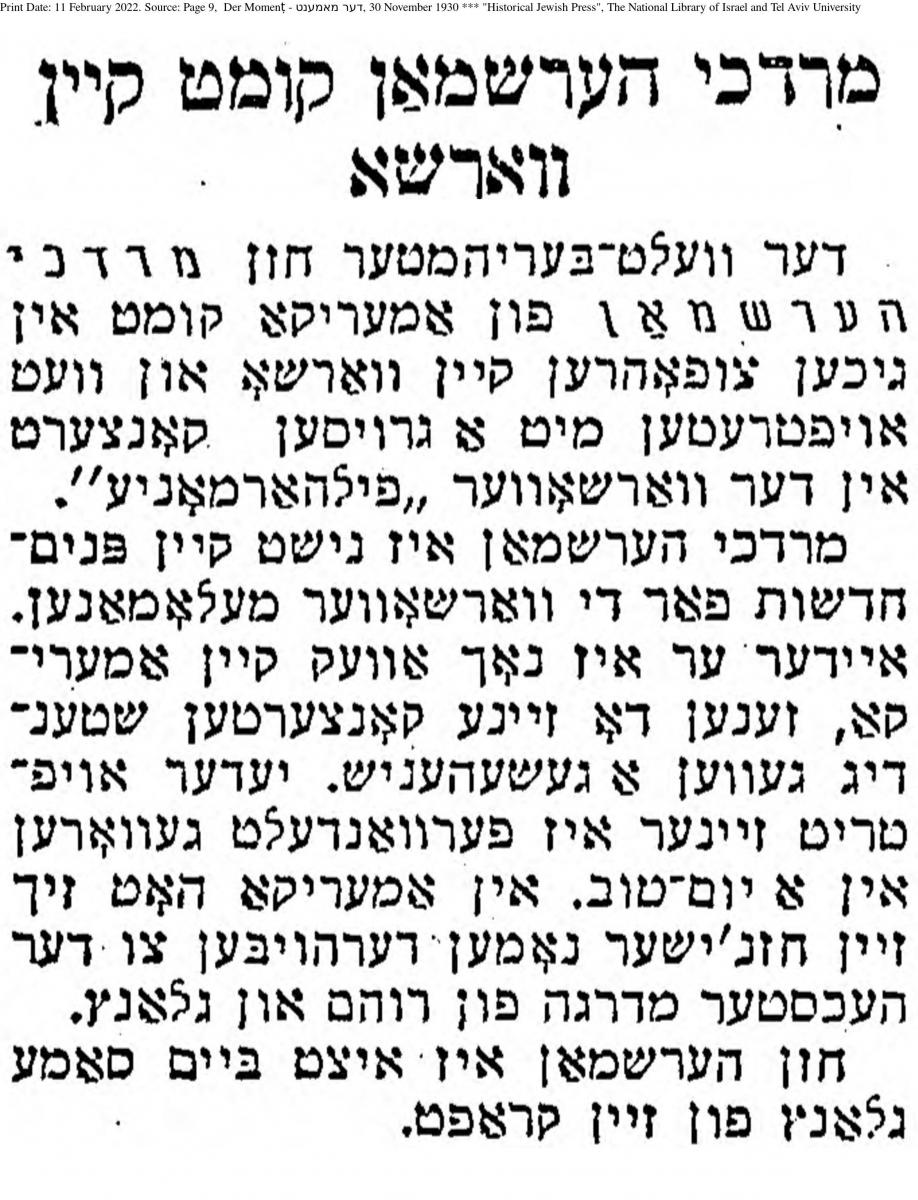
The Hebrew press in British Palestine profusely advertised Hershman’s concerts. On May 9, 1933 the daily Haaretz run a main title announcing, the imminent coming of the “well-known cantor Mordecai Hershman to the Land of Israel.” The size of the title equals the one announcing of the moving to a new location by the main agency of a large bank.

Indeed, on August 10, 1933, Haaretz published the announcement of the expected concert in Beit Ha’am of Tel Aviv by “the world-renowned cantor Mordercai Hershman with a rich program”.

On March 1, 1934, Davar the newspaper of the socialist Worker’s Union, advertised morning liturgical services at the Ohel Shem theater led by the famous cantor Mordecai Hershman accompanied by a choir conducted by Leo Low. The Association of Devotees of Hazzanut and Hebrew Song in Tel Aviv (Agudat hovevei hahazanut vehashirah ha’ivrit betel aviv) sponsored the service for which tickets of different prices were sold, showing the porous line separating secular from the religious musical practices led by great cantors of the time such as Hershman.
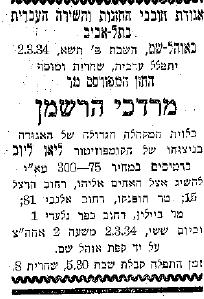
As was customary of some noted hazzanim of the time, Hershman released not only recordings of cantorial music but also folk songs in Yiddish.
As the following announcement (Der Moment of February 27, 1936) shows, Hershman’s voice was also heard in the screening of the film 'Shir Hashirim” an early Yiddish talkie, when it was presented at the “Metro” cinema theater in Warsaw. The film, based on the 1911 operetta of the same name with a libretto by Anshel (Albert) Schorr (1871-1942) and music by Yosef (Joseph) Rumshinsky, featured Samuel Goldenburg and Dora Weissman. This Polish screening of “Shir Hashirim” included also the renowned Yiddish vaudeville actor Menashe Skolnik.

Hershman died in New York and the following obituary from the Forverts of January 31, 1941 expresses the Jewish community’s admiration for the late cantor.

A notice in Haaretz, April 2, 1941, provides a late notice of Hershman’s death in New York earlier in the year.
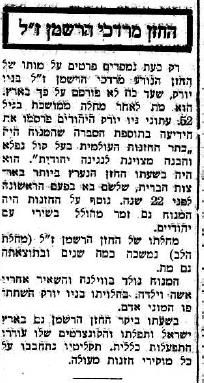
Hershman and the Hebrew University
In 1925, cantor Pinchas Jassinowski composed for Hershman the piece entitled 'At the end of days' (Vehaya beaharit hayamim) on the occasion of the opening of the Hebrew University campus on Mount Scopus in Jerusalem (on this piece see also David Assaf's blog). The text, that attracted many Jewish composers, is from the Book of Isaiah (2:1-4) and the uniquely expressive through-composed musical score (8:30 minutes long, published in New York by Renanah Music, 1925) is based, among other motifs, on the traditional Haftarah cantillation. Hershman recorded this master piece in the United States accompanied by a chamber orchestra consisting of strings and wind instruments. His pristine singing is devoid of any cantorial bravado, reaching a climax at around 5:00 ('Torah will go out from Zion, and the word of Adonai from Jerusalem') and ending in a highly meditative mood, almost sotto voce, with the opening words of the text ('at the end of days').
Sources
Klein, Amit. “Changing Performance Styles of Twentieth Century Ashkenazi Cantorial Recitatives.” Analytical Approaches to World Music 3 (2014), no. 2. Includes detailed analyses of recordings by Hershman.
Smith, Edward G. Notes to the LP Fifty minutes with Modercai Hershman, Shirim Records S-1002, published after 1953.
Zaludkowski, Elias. Kulturtrager von der judischen liturgie: Historish-biyografisher iberblik iber hazanut, hazonim un dirizsharn. Detroit, 1930, pp. 275-6.
Sound and Video Resources
A rich repository of recordings by Hershman can be found in several libraries, archives and of course on YouTube.
For example, you can listen to Hershman’s amazing voice at the National Library of Israel
https://www.nli.org.il/he/items/NNL_MUSIC_AL000227512/NLI
At Florida Atlantic University:
https://rsa.fau.edu/album/42283
At the Dartmouth Archive of Jewish Sound that includes no less than 512 entries.
Herschman also appeared in film clips
https://www.youtube.com/watch?v=9FB7zy-t8bQ
https://www.youtube.com/watch?v=jxYk0tk8_8c
The following video clip includes many visuals of Hershman’s life
https://www.youtube.com/watch?v=sF_qcsZXuZQ
Online Writings about Mordecai Hershman
Biographical information on Hershman is based on few sources that are reproduced repeatedly. The following biographical write up by Rabbi Geoffrey Shisler (https://geoffreyshisler.com/biographies-2/mordecai-hershman/ reproduced in http://www.chazzanut.com/articles/hershman.html) draws substantially from the notes in the back of the LP, Fifty minutes with Mordecai Hershman, published in the mid-1950s. whose original appears below. The same text appears in Wikipedia: https://en.wikipedia.org/wiki/Mordechai_Hershman. We have corrected typos, pointed to unidentified names and added some hyperlinks:
Like so many of the great Chazanim of the Golden Age of Chazanut, Mordecai Hershman was a Russian. He was born in Cherinov in 1888, and his father, who was a glass-merchant, had no interest in singing whatsoever. Sadly, Mordecai was orphaned at the age of six and it turned out that his foster parents were equally disinterested in music. However, it may well have been their discouragement that turned the young Hershman towards the Synagogue in order to satisfy his thirst for singing, and it was through the pleadings of the local cantor with his foster parents that Mordecai was allowed to take lessons.
At the age of twelve, he was adopted by his grandfather who took him to Solovio [unidentified location], where he continued his studies under Chazan Dorfman [unidentified]. By 1905 Chazan Dorfman considered his protégé to be ready and he applied for, and was appointed, Chazan Sheni (Assistant Cantor) to the Vilna Synagogue, earning 12 roubles a month! When the incumbent Chazan Rishon (Chief Cantor) died, Hershman applied for the position, and against some extremely fine opposition, he was appointed Chazan Rishon himself. Since Vilna was one of the most flourishing centers of Jewish life, at this time, this post Rishon at the main Synagogue was indeed a coveted one.
In 1914 Hershman was drafted into the army and it's related that his commanding officer was so impressed with his singing, that he was released from army service and returned to his Synagogue. (This, and similar apocryphal stories, are related about many Chazanim. It is of course very difficult to verify, but is a charming notion nevertheless!) After 1918 Hershman sang extensively throughout Russia and the rest of Europe. He became so famous that his own Synagogue released him to officiate only twice per month and he conducted services in many communities on the other Shabbatot. In concert he often sang operatic arias and appeared as soloist, twice, with the Warsaw Philharmonic.
The famous Choir Director Leo Low heard him and invited him to go to America which he did in 1920 where he was appointed Chazan at the Temple Beth-El in Boro Park, Brooklyn. Hershman toured and concertized all over the States, as well as conduct services in all the major Synagogues. He died at the very early age of 52 in 1941, deeply mourned by countless admiring fans.
We are fortunate to have many recordings of Mordecai Hershman in which we can still thrill to his high, lyrical, tenor voice. Some of his recordings have become classics and are frequently performed by modern Chazanim. Eilu Devarim, Shma Koleinu and Aneinu are amongst the most well-known and many Chazanim use his rendering of the Beracha for Hallel as standard. You are also very likely to hear his Sheva Berachot being sung (though not, perhaps as he would have sung them himself!)

A similar biography, http://www.historicaltenors.net/russian/hershman.html adds the following new piece of information regarding his military service:
However, something must have singled that military service out, and somehow, he seems to have been exempted from all true military activities – different sources say either because his commanding officer was so impressed by his voice, or because cantor David Roitman arranged his dismissal from the army and a temporary position for him at the synagogue in Kremenchuk.
Cantor Sam Weiss prepared a more detailed biography, using Zaludkowski, published by klezmerschack: https://www.klezmershack.com/articles/weiss_s/luminaries/#hershman. It is reproduced here:
Hershman, Mordechai, noted cantor; b. Chernikhov (Ukraine) 1888; d. Israel [sic], January 20, 1941
Defying his father, who considered a life of song to be beneath the dignity of a respectable mercantile family, he became apprenticed to seven different cantors in as many Ukranian towns from his early teens through early adulthood. He was the star soloist in the choirs of such East European cantorial celebrities as Nisi Belzer and Zeidel Rovner, who provided his musical and professional grounding. In 1913 he obtained his first cantorial position, at the synagogue in Zhitomir, but a few months later he became the cantor of the prestigious Great Synagogue of Vilnius (Lithuania), a significant accomplishment for a man of 25. With the advent of World War I he was drafted into the army, but was released from active duty by a commanding officer who was moved by his singing at a special synagogue commemoration. He maintained his position there until 1920, when he immigrated to America.
Although he had concertized and achieved fame in Europe, due to wartime disruptions he was not at first well known to the American Jewish community. Word of his resplendent tenor voice and excellent musicianship spread quickly, however, and soon he, Yossele Rosenblatt and Zavel Kwartin (1874-1952) became the three pre-eminent figures of the cantorial Golden Age—each with his own distinctive strengths and fiercely loyal following. In the 1920's and 1930's the recordings of one or all of these cantors were to be found in most Jewish households with phonograph players. Not being a composer, Hershman used his interpretive abilities and lustrous voice to sing and record fine liturgical recitatives by a variety of composers. Many of these pieces have entered the repertoire of other cantors and have remained popular to this day, due to their beautiful cantabile passages and absence of excessive coloratura. He also recorded a relatively large number of Yiddish folksongs and art songs; these too were sung by many other singers, most notably Jan Peerce. While the immense popularity of his recordings can be attributed to his classic vocal technique and artistic performances, their appeal was further enhanced by their effective orchestral arrangements.
In 1922, after two years of concertizing and recording, he accepted a year-round cantorial position with Congregation Beth-El in Brooklyn, N.Y., which at the time was housed in a modest-sized building; but his services attracted such crowds, that the synagogue needed to expand to its present-day grand structure. His relationship with that congregation continued until the advent of the depression in 1929, when he released his congregants from their long-term contract. In 1931 he appeared as one of the featured cantors in Joseph Seiden's film 'The Voice of Israel.' In 1933 he left the U.S. for his first visit to Israel, where, among other activities, he conducted the funeral service for his colleague Yossele Rosenblatt. Upon his second visit, in 1935, he officiated at the Great Synagogue in Tel-Aviv. Illness caused him to return to America; and only in 1937 was he able to finally settle in Israel.
Discography CD: Pearls of Jewish Liturgical Music: Cantor Mordechai Hershman (Aderet, 1995); Jewish Folk Songs (Aderet, 2002); Also appears on: Mysteries Of The Sabbbath—Classic Cantorial Recordings: 1907–1947 (Yazoo #7002, 1994); Great Voices Of The Synagogue (Tara); Golden Age of Cantors (Tara).
Cassette: Art of Cantor Mordechai Hershman Vols. 1–5 (Greater Rec. Co., 1973); Mordechai Hershman Sings Cantorials (Greater Rec. Co., 1973); Art of Cantor Mordechai Hershman (Aderet, 1989)
Video: Great Cantors of the Golden Age [an updated version of the 1931 film The Voice of Israel] (1990)
The following is the original text by Zaludkowski (1930):






